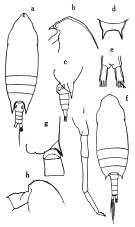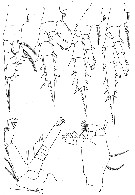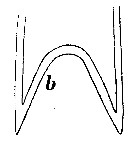|
|
 |
Fiche d'espèce de Copépode |
|
|
Calanoida ( Ordre ) |
|
|
|
Clausocalanoidea ( Superfamille ) |
|
|
|
Aetideidae ( Famille ) |
|
|
|
Aetideus ( Genre ) |
|
|
| |
Aetideus bradyi A. Scott, 1909 (F, ?M) | |
| | | | | | | Syn.: | Euaetideus bradyi : Wilson, 1942 a (p.183); C.B. Wilson, 1950 (p.202, Descr.M, figs.M); Vervoort, 1957 (p.48, figs.F); Fagetti, 1962 (p.17); Grice, 1962 (p.192, figs.F, Rem.); Vervoort, 1963 b (p.122, Rem.); Fleminger, 1967 a (tabl.1); Vidal, 1968 (p.27, figs.F); Tanaka & Omori, 1970 (p.111); Björnberg, 1973 (p.327, 385); Dawson & Knatz, 1980 (p.6, figs.F,M); Björnberg & al., 1981 (p.604, 630, fig.F); Herman & Mitchell, 1981 (p.739, Table 2, length-volume); De Decker, 1984 (p.316); Brinton & al., 1986 (p.228, Table 1); Palomares Garcia & Vera, 1995 (tab.1); Jimenez-Perez & Lara-Lara, 1988; Rosales & Sepulveda, 1992 (p.38); Escribano & Hidalgo, 2000 (p.283, tab.2); Hidalgo & Escribano, 2001 (p.159, tab.2); Escribano, 2006 (p.20, Table 1); Ayon & al., 2008 (p.238, Table 4: Peruvian samples); Escribano & al., 2009 (p.1083, Table 1, figs.6, 10); Tutasi & al., 2011 (p.791, Table 2, abundance distribution vs La Niña event) | | | | Ref.: | | | A. Scott, 1909 (p.38, Descr.F, figs.F); Tanaka, 1953 (p.130); 1957 a (p.34, figs.F,M); Markhaseva, 1996 (p.17, figs.F, Rem.); Chihara & Murano, 1997 (p.682, Pl.33: F) |  issued from : O. Tanaka in Publ. Seto Mar. Biol. Lab., 1957, VI (1). [p.35, Fig.24]. Female: a, habitus (dorsal); b, forehead (lateral); c, last thoracic segment and urosome (lateral left side); d, rostrum; e, anal segment and furca. Nota: Crest well marked (in lateral view). Rostrum short and strong, with divergent points; knob-like processes of inner side of the wide base are observed in trace. Proportional lengths of urosomites and furca 35:18:12:15:20 = 100. Furcal rami two times as long as wide, appendicular seta long. A1 (25-segmented) reaches back to distal margin of 4th urosomal segment. Male: f, habitus (dorsal); g, last thoracic segment (lateral); h, forehead (lateral); i, P5. Nota: Forehead slightly chitiniseed. Rostrum represented by a small knob-like projection (in lateral view). Proportional lengths of urosomites and furca 19:22:19:19:4:17 = 100. A1 reaches back to distal margin of 2nd urosomal segment. Mx1: outer lobe with 5 long setae, exopod with 10 setae.
|
 issued frm : A. Scott in Siboga-Expedition, 1909, XIX a. [Plate V, Figs.1-12]. Female (from Indonesia-Malaysia): 1, hhabitus (dorsal); 2, forehead (lateral); 3, last thoracic and genital segments (left side); 4, rostrum; 5, A1; 6, A2; 7, Md; 8, Mx2; 9, Mxp; 10, P1; 11, P2; 12, P4. Nota: The last thoracic chitinized spines are sometimes easily damaged.
|
 issued from : W. Vervoort in B.A.N.Z. Antarctic Reseach Expedition, Report Ser. B, Vol. III., 1957 [Fig.21]. As Euaetideus bradyi. Female: a, c, habitus (lateral and dorsal, respectively); b, right A1; d, forehead (lateral); e-f, posterior part cephalothorax and urosome (lateral and dorsal, respectively).
|
 issued from : W. Vervoort in B.A.N.Z. Antarctic Reseach Expedition, Report Ser. B, Vol. III., 1957 [Fig.22]. As Euaetideus bradyi. Female: a, right P1 (anterior); b-d, P2 to P4 (left legs); e, right A2; f, right Md (mandibular palp).
|
 issued from : W. Vervoort in B.A.N.Z. Antarctic Reseach Expedition, Report Ser. B, Vol. III., 1957 [Fig.23]. As Euaetideus bradyi. Female: a, right Mx2; b, left Mx1; c, left Mxp; d, Md (cutting edge).
|
 issued from : W. Vervoort in B.A.N.Z. Antarctic Reseach Expedition, Report Ser. B, Vol. III., 1957 [Fig.20 b]. As Euaetideus bradyii. Female: distal portion of rostral plate.
|
 issued from : E.L. Markhaseva in Trudy Zool. Inst. RAN, St. Petersburg, 1996, 268. [p.17, Fig.5]. Female (from 12°49'S, 96°58'E). R: rostrum (anterior); Ce: cephalon (lateral).
|
 Aetideus bradyi Aetideus bradyi female: 1 - Posterior corners of last thoracic segment prolonged into wing-like lobes pointed at tops, reaching at least the middle of urosomal segment 2. Anterior part of cephalon with crest. 2 - Excavation between rostral rami without thickenings.
| | | | | Ref. compl.: | | | Sewell, 1948 (p.347, 545, 550, 551, 566, 568); Furuhashi, 1966 a (p.295, vertical distribution in Kuroshio region, Table 9); Chahsavar-Archad & Razouls, 1982 (p.37); Brenning, 1983 (p.2, Rem.); 1985 a (p.28, Table 2); Suarez-Morales & Gasca, 1998 a (p107); Lapernat, 2000 (tabl.3, 4); Razouls & al., 2000 (p.343, Appendix); Suarez-Morales & al., 2000 (p.751, tab.1); Rebstock, 2001 (tab.2); 2002 (p.71, Table 3, Fig.4, climatic variability); Shimode & Shirayama, 2004 (tab.2); Lavaniegos & Jiménez-Pérez, 2006 (p.135, tab.2, 4, Rem); Lopez Ibarra, 2008 (p.1, Table 1: abundance, Table 2: Rem.); Galbraith, 2009 (pers. comm.); Hernandez-Trujillo & al., 2010 (p.913, Table 2); Palomares-Garcia & al., 2013 (p.1009, Table I, abundance vs environmental factors); in CalCOFI regional list (MDO, Nov. 2013; M. Ohman, pers. comm.); Mendoza Portillo, 2013 (p.37: Fig.7, seasonal dominance); Lidvanov & al., 2013 (p.290, Table 2, % composition); Lopez-Ibarra & al., 2014 (p.453, Table 2, biogeographical affinity); Fierro Gonzalvez, 2014 (p.1, Tab. 3, 5, occurrence, abundance); Zakaria & al., 2016 (p.1, Table 1, Rem.) | | | | NZ: | 15 | | |
|
Carte de distribution de Aetideus bradyi par zones géographiques
|
| | | | | | | | | | | | | | |  issued from : J.M. Bradford in N.Z. Jl Mar. Freshw. Res., 1971, 5 (1). [p.35, Fig.14]. issued from : J.M. Bradford in N.Z. Jl Mar. Freshw. Res., 1971, 5 (1). [p.35, Fig.14].
North Pacific Ocean showing distribution of four Aetideus species. |
| | | | Loc: | | | Antarct. (Pacif. SE), South Africa (E), G. of Guinea, NW Africa, off S Cape Verde Is., off Morocco-Mauritania, S Brazil, Indian, Madagascar, Indonesia-Malaysia, Philippines, China Seas (East China Sea), off Taiwan, Japan (Izu), Pacif. (W equatorial), Pacif. (equatorial), E Pacif., Queen Charlotte Is., Vancouver Is., California, Baja California (Bahia Magdalena), G. of California, W Mexico, Galapagos-Ecuador, Peru, Chile, (N & S, sub-Antarct., off Valparaiso, Mejillones Peninsula), E Medit. (W Egyptian coast inZakaria & al. (2016)
Type locality: Malay Archipelago. | | | | N: | 50 | | | | Lg.: | | | (5) F: 1,8; (14) F: 1,67-1,375; (25) F: 1,69; (37) F: 1,8-1,38; (39) F: 1,46; M: 1,4; (101) F: 1,7-1,6; (113) F: 1,5; (137) M: 1,5; (187) F: 1,84-1,81; (202) F: 1,69-2,07; (866) F: 1,38-1,7; M: 1,5; (1109) F: 1,63; {F: 1,375-2,070; M: 1,400-1,500}
The mean female size is 1.653 mm (n = 17; SD = 0.1895), and the mean male size is 1.467 mm (on 3 specimens only). The size ratio (male : female) would be approximately 0.96. | | | | Rem.: | Vervoort (1963 b) émet des doutes sur l’identification de cette espèce par Tanaka (1953, 1957) et Tanaka & Omori (1970).
Markhaseva (1996) n’ admet pas la validité des mâles décrits par Wilson (1950) et Tanaka (1957 a).
Sampling depth (Antarct., sub-Antarct.) : 0-100 m.
Voir aussi les remarques en anglais | | | Dernière mise à jour : 03/12/2020 | |
|
|
 Toute utilisation de ce site pour une publication sera mentionnée avec la référence suivante : Toute utilisation de ce site pour une publication sera mentionnée avec la référence suivante :
Razouls C., Desreumaux N., Kouwenberg J. et de Bovée F., 2005-2025. - Biodiversité des Copépodes planctoniques marins (morphologie, répartition géographique et données biologiques). Sorbonne Université, CNRS. Disponible sur http://copepodes.obs-banyuls.fr [Accédé le 05 janvier 2026] © copyright 2005-2025 Sorbonne Université, CNRS
|
|
 |
 |











